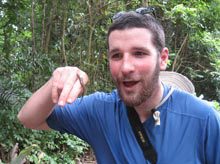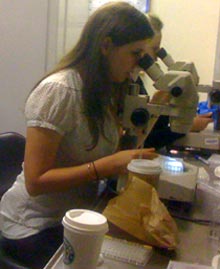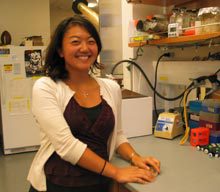Itamar Haritan

I am interested in the personal and political transformations that occur at the beginning and throughout the process of mobilization for social change. In particular, I am interested in the activities of the Jerusalem Open House, a grassroots organization that is the politically active community center of the LGTBQ community in Jerusalem, a city deeply divided along various lines where even close daily contact does not translate into mutual understanding between different communities. By volunteering and interviewing individuals in the Open House, I hope to understand the personal-political transformations that […]
Matthew McElroy

I am interested in the thermal ecology of two tropical skinks, Emoia cyanura and E. impar, in Tahiti, French Polynesia. Since these skinks are so similar in morphology and ecology, they likely compete for essential resources, including sources of heat. So far, through field observations and lab experiments, I have found that E. cyanura prefers open canopy habitats and warmer body temperature relative to E. impar. To expand my study, I will test sprint speed of each species at different body temperatures to see if they are thermal “generalists” or […]
Lauren Zerbib

The basis of sexual reproduction is a perennial topic of interest in evolutionary biology. The rotifer, Brachionus Calyciflorus, is an interesting system to compare sexual and asexual reproduction because it is cyclically parthenogenetic, meaning it alternates between generations produced sexually and asexually. By understanding the mechanisms controlling the timing of sexual reproduction in such organisms, we can better understand how natural selection determines the balance between asexual and sexual reproduction. In this study I look at the contributions of three related factors in determining the proportion of sexually reproducing daughters […]
Jenny Hua

With the amazing economic transformations China has shown the world in the past several decades comes an expectation for the country to show signs of also transforming politically. What is the ideological glue that holds the country together after the obsolescence of Marxist-Leninism and Maoist thought? Nationalism seems to be the new official religion of China. Through participant observation in a few Shenzhen high schools, I want to see how nationalism is conceptualized and combined with morality specifically within the Chinese education system. I hope to observe the effect that […]
Jane O

Because any given cell carries an overwhelming excess of genetic information, they need a way to selectively pinpoint what they need, when they need it. Silencing entire regions of the genome via chromatin modifications is one method that eukaryotes have developed to great effect. The four SIR (Silent Information Regulator) genes are absolutely critical to silencing in yeast. Wild-type Sir3 typically requires Sir2s deacetylation activity, and not just the deacetylation itself, in a mechanism that is still unclear. I will use sequencing and protein structural analysis to study PCR generated […]
Julia Selezneva
The core goal is to identify the origin of antibiotic drug-resistance determinants, with the hypothesis that drug-resistance determinants, in particular integrons carrying gene cassettes coding for drug resistance, from bacteria that is ingested through uncooked food (spinach, animal meat) can horizontally transfer to commensal bacteria in the human intestine, and under selective pressure of antibiotics, and ultimately lead to complicated multi-drug resistant bloodstream or urinary tract infections. Integrons are mobile genetic elements, found on transposons, plasmids and chromosomes that capture and express gene cassettes by site-specific recombination. This summer I […]
Branda Brehm

I am researching the relationship between Marcel Prousts la recherche du temps perdu and cinema in light of how each produces images. The prose of Marcel Proust is often termed cinematic, yet it is executed in a medium that is vastly different from film. What is it then about the image at this point in its history that allows for a comparison between this major work of literature and the fundamental techniques of the cinema? To answer this question I am researching the underlying philosophy of Prousts imagery of time […]